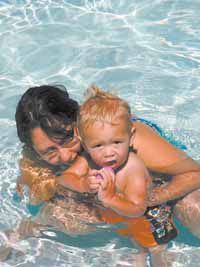| Athena and Derick Robison enjoy an afternoon swimming at the Price City Desert Wave Pool. Adult supervision is key to preventing drownings. Although a child may know how to swim, a drowning can occur in a matter of seconds and through proper supervision, serious injury and even death can be avoided. |
The number of dangers that children face on a daily basis are countless. During the summer months however, it seems as if children face many more dangers than any other time of year. In order to avoid accidents from happening, Carbon County adults may take simple steps which will ensure any child’s safety.
Because many families take vacations during the summer months, the risk of a child being hurt in a traffic accident increases. Therefore it is extremely important to obey all seat belt laws and make sure that each child is properly buckled each time the car pulls out of the driveway.
According to child safety experts, each year, car crashes injure and kill more kids than any disease. These injuries and deaths can be prevented by using safety seats and belts properly.
The National Safe Kids Campaign advises parents to always read and follow the directions included with any safety seat. By doing so, adults will reduce the risk of serious injury to a child in the event of an accident.
The Utah Highway Safety Office specifies that children age 4 to at least 8 or who weigh 80 pounds should ride with a belt positioning booster seat. Once a child is big enough to wear a lap and shoulder belt only, the safe kids group advises that the shoulder strap must fit snugly. The safety experts also warn parents to never allow a child to wear the shoulder belt under their arm or behind their back. The lap belt must also fit low and snug across the hips, not the stomach.
Before a child can advance to a booster seat, they must use a certified safety seat. This means that children between 20 and 40 pounds must be secured in a seat during all car rides. Children who fall into this category may ride forward facing.
Infant only seats are used for children who weigh up to 20 pounds advises the national children’s safety group. These seats must be rearward facing. This position protects the infant’s fragile neck and chest indicates the Safe Kids Campaign.
Some safety seat manufacturers make convertible seats which are designed for children up to 40 pounds. These seats are used for rear-facing infants as well as forward-facing children after age 1 and between 20 and 40 pounds.
The Utah safety group warns parents to never place a rear-facing infant seat in the front seat when a passenger side airbag is present. In fact, the highway safety organization advises Carbon residents that children age 12 and under are safest in the rear seat of a vehicle when properly belted.
Because children learn by example, safety experts advise adults to buckle up each time they enter a vehicle. Because safety belts play such an important role in preventing injury, seat belt use is required by Utah state law.
According to the state law, children 0 through 4 must be properly retrained in an approved car safety seat in a motor vehicle advises the highway safety council.
Utah law also requires that the driver and all passengers be buckled if a seat belt is available.
As part of a statewide campaign to make sure that Utah residents are traveling safe, the law states that any motorist may be stopped and cited if anyone under 19 years of age is unrestrained. Any occupants 19 and older may also be cited for not wearing a seat belt.
Many times, families will travel and once they have reached their destination, they will enjoy a dip in a swimming pool. Water safety is extremely important and is necessary anytime a child is near water.
According to the National Safe Kids Campaign, drowning is the leading cause of unintentional death in the U.S. Most drowning and near drowning happen when a child unintentionally falls into a pool or is left alone in the bath tub.
Because drowning happen in a matter of seconds, it is important to never leave a child unattended while in or near water. Safety experts explain that children under 5 are at especially high risk of drowning. It only takes an inch of water and a short moment for a child to drown.
It is recommended that children over the age of 3 enroll in swimming lessons taught by a certified instructor. But Carbon parents should remember that lessons does not make a child drown proof. Whether at home, on vacation or at a nearby pool, lake or reservoir, children must always be supervised while near water.
Children should never be allowed to play near ponds or canals without adult supervision. They should also be required to wear a U.S. Coast Guard approved life jacket while boating, fishing or participating in any outdoor activity involving water.
The National Safe Kids Campaign provides the following tips for young swimmers which may save a life.
•Swim with a buddy, never alone.
•Don’t dive or jump into bodies of water. Always wade in first to avoid hitting the head on a shallow bottom.
•Don’t push or jump on others.
By following simple guidelines and creating a safe atmosphere for children, Carbon County adults may provide an injury free summer experience for local youth this summer.
Editor note: This story is the second installment in a series of news articles highhlighting children’s outdoor and summer safety.

